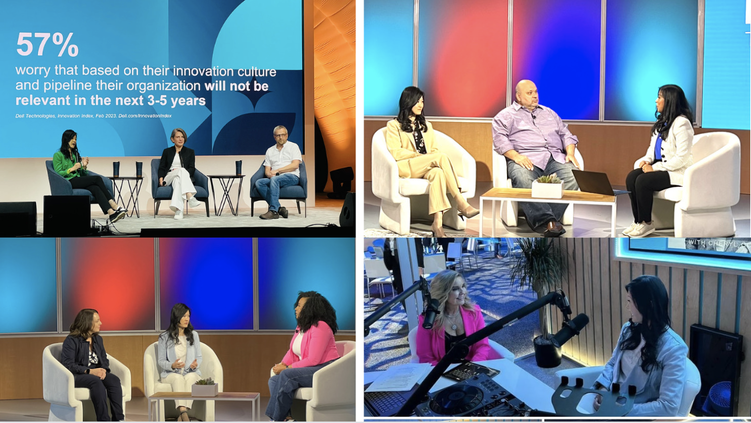TECHNOLOGY
Accelerating Change and Shaping the Future

Innovation, a word that rolls off the tongue effortlessly, yet achieving it successfully and consistently can be an arduous endeavor.
We all aspire to innovate, to create something extraordinary, to push the boundaries of what is possible. And yet, the road to innovation is riddled with challenges and uncertainties.
Dell Technologies, recognizing the significance of innovation in shaping out future, conducted a global benchmark study, the innovation index. Its findings were both eye-opening and thought-provoking. Astonishingly, 57% of respondents expressed concerns that their organizations, with their current innovation culture and pipeline, may become irrelevant within the next 3-5 years. Additionally, 64% acknowledged that certain aspects of their company’s culture were hindering their innovation potential.
These statistics paint a stark picture, one that demands our attention and action. The truth is, in this rapidly changing landscape, innovation is not a mere luxury, it is an imperative. It is the driving force that propels organizations forward, enabling them to adapt, thrive, and remain relevant amidst constant disruption.
But what does it truly mean to innovate? It goes beyond launching new products or services and hoping for success. It involved fostering a culture that values experimentation, learning from failure and embracing the unknown. Innovation is a mindset, a way of thinking that permeates every aspect of an organization, from its leadership to its employees.
To delve deeper into the topic of driving innovation culture, I had the privilege of hosting two remarkable experts at Dell Tech World. Tim Bicio the visionary CTO of Lightstorm Entertainment, and Jen Felch, Dell Technologies’s esteemed Chief Digital Officer and CIO, graced us with their invaluable insights.

We explored the pivotal role that tech leaders play in shaping an innovation culture, one that nurtures the right skills and mindsets within their teams. Jen eloquently expressed the significance of tech leaders’ involvement from the beginning, working in collaboration with HR leaders and engaging employees transparently. Culture, she emphasized, sets the norms and behanviors within a team, and it is the responsibility of leaders to drive and cultivate it.
Tim Bicio, drawing from his experience of pushing boundaries in the entertainment industry, shared his perspectives on bridging generational mindsets, strengthening skill sets, and empowering teams in the hybrid work environment. His insights were both inspiring and enlightening, reminding us that innovation knows no boundaries and that nurturing an innovation culture can be a competitive advantage.
The conversations then led us to explore how technology can empower our workforce to work and innovate from anywhere. Jen shared her wisdom on balancing the act of pushing boundaries while ensuring productivity and security. She discussed the Importance of personalization, unified management across devices, and secure access to network and data.
Burzin Engineer, the Co-Founder and Chief Reliability Officer of PhonePe, joined me in a fireside chat on sustainable data centers. We uncovered the transformative potential of sustainable innovation, aligning eithical principles with long-term value for both businesses and the planet. Burzin shared how PhonePe has prioritized sustainability in its data centers, embracing alternative cooling technologies and reaping tangible benefits.
In addition, Jaynene Hapanowicz, Dell Technologies’s CTO and SVP of Technology Transformation and I engaged in a powerful digital broadcast about the future of work. We explored the tremendous strides made in working from everywhere, the importance of maintain momentums, and the need to keep pushing forward. This entails developing a deliberate strategy that tailored to your needs, and providing people reliable and secure connectivity to be productive, innovative driving sustainable success working from everywhere. According to Dell’s Innovation Index, ITDMs are struggling in some areas such as providing technology for individual needs and preferences, ensuring secure remote work for their employees. Organizations should start with a human-centered approach and involve their employees when designing the future of work strategy. To drive productivity and creativity, IT leaders should focus on providing more intelligent and responsive technology to improve the work experience. This can be achieved by understanding pain points, user expectations, and designing a technology roadmap together with the business. Deploying technologies with proper training and support is crucial, considering digital fluency and technical skills. The audience can start today by empowering their people to make decisions about where they work based on their needs, which will spark creativity and foster innovation.
Lastly, I enjoyed being featured on The Partner Connection Podcast, hosted by Cheryl Cook, SVP of Global Partner Marketing at Dell Technologies. We explored “Lessons learned from Dell Innovation Index and how to accelerate innovation”. Here are a ew highlights of the learnings:
-
Perception gap: while an overwhelming 71% of the organizations regard themselves as innovative or extremely innovative, only a mere 18% can truly be classified as innovative. This perception gap is concerning and highlights the need for self-reflection and improvement.
-
Relevancy: 57% of organization worry that their current innovation culture and pipeline might render them irrelevant in 3-5 years.
-
Accelerating growth: during times of turbulence and economic uncertainty, innovation leaders and adopters are 2.2 times more likely to accelerate growth, gaining a substantial competitive advantage. This statistic showcases the tangible benefits that organizations reap when they prioritize innovation.
Cheryl then steered the conversation towards the question of what leaders do well and how we can learn from them. I addressed this from people, process, and technology perspectives:
-
Innovation becomes a talent magnet, attracting skilled individuals to their teams. By fostering an innovation culture that encourages learning from failure and empowers everyone to contribute their ideas, they create an environment where innovation thrives. Forward-looking leaders collaborate with external partners to identify trends, forecast future needs, and bridge skill gaps.
-
Dell Innovation Index uncovered some concerning insights. Only 52% organizations align innovation initiatives to company goals, while a mere 26% base their innovation decisions on data. However, the innovation leaders take a holistic approach, securing stakeholders buy-in and employee involvement through consistent communication, running pilots to demonstrate proof of concept, and hosting hackathons or scrums to foster innovation and collaborative problem-solving.
-
Future-ready leaders recognize the strong correlations between technology maturity, intention, and successful innovation. Challenges such as the speed of tech advances and resulting complexity can hinder organizations, with 57% expressing concern that their technology is not cutting-edge. However, leaders invest in modern, scalable technologies and nurture the partnership between IT and business to increase tech and innovation maturity.
-
Let us not forget that building a strong innovation practice does not mean resting on our laurels. The world is in a constant state of change, and leaders must continuously adjust across people, processes, and technology.
The path to innovation may be challenging and uncertain, but it is through embracing innovation that we can accelerate change and propel ourselves forward. It is evident that organizations must prioritize innovation to remain relevant in the ever-evolving landscape. Innovation goes beyond the launch of new products or services; it requires a cultural shift that values experimentation, embraces failure as a learning opportunity, and empowers every individual within an organization.
I have been fortunate to play an active part at Dell Tech World, hearing from visionary leaders who have shared their experiences and perspectives on driving innovation culture. They have reminded us that innovation knows no boundaries and that fostering an environment that nurtures creativity and empowers teams is a competitive advantage.
Innovation is not a destination, but a continuous journey. It requires constant adaptation and adjustment across people, process, and technology. By embracing innovation, we have the power to shape a brighter future, overcome challenges, and unlock limitless possibilities.
TECHNOLOGY
Next-gen chips, Amazon Q, and speedy S3

AWS re:Invent, which has been taking place from November 27 and runs to December 1, has had its usual plethora of announcements: a total of 21 at time of print.
Perhaps not surprisingly, given the huge potential impact of generative AI – ChatGPT officially turns one year old today – a lot of focus has been on the AI side for AWS’ announcements, including a major partnership inked with NVIDIA across infrastructure, software, and services.
Yet there has been plenty more announced at the Las Vegas jamboree besides. Here, CloudTech rounds up the best of the rest:
Next-generation chips
This was the other major AI-focused announcement at re:Invent: the launch of two new chips, AWS Graviton4 and AWS Trainium2, for training and running AI and machine learning (ML) models, among other customer workloads. Graviton4 shapes up against its predecessor with 30% better compute performance, 50% more cores and 75% more memory bandwidth, while Trainium2 delivers up to four times faster training than before and will be able to be deployed in EC2 UltraClusters of up to 100,000 chips.
The EC2 UltraClusters are designed to ‘deliver the highest performance, most energy efficient AI model training infrastructure in the cloud’, as AWS puts it. With it, customers will be able to train large language models in ‘a fraction of the time’, as well as double energy efficiency.
As ever, AWS offers customers who are already utilising these tools. Databricks, Epic and SAP are among the companies cited as using the new AWS-designed chips.
Zero-ETL integrations
AWS announced new Amazon Aurora PostgreSQL, Amazon DynamoDB, and Amazon Relational Database Services (Amazon RDS) for MySQL integrations with Amazon Redshift, AWS’ cloud data warehouse. The zero-ETL integrations – eliminating the need to build ETL (extract, transform, load) data pipelines – make it easier to connect and analyse transactional data across various relational and non-relational databases in Amazon Redshift.
A simple example of how zero-ETL functions can be seen is in a hypothetical company which stores transactional data – time of transaction, items bought, where the transaction occurred – in a relational database, but use another analytics tool to analyse data in a non-relational database. To connect it all up, companies would previously have to construct ETL data pipelines which are a time and money sink.
The latest integrations “build on AWS’s zero-ETL foundation… so customers can quickly and easily connect all of their data, no matter where it lives,” the company said.
Amazon S3 Express One Zone
AWS announced the general availability of Amazon S3 Express One Zone, a new storage class purpose-built for customers’ most frequently-accessed data. Data access speed is up to 10 times faster and request costs up to 50% lower than standard S3. Companies can also opt to collocate their Amazon S3 Express One Zone data in the same availability zone as their compute resources.
Companies and partners who are using Amazon S3 Express One Zone include ChaosSearch, Cloudera, and Pinterest.
Amazon Q
A new product, and an interesting pivot, again with generative AI at its core. Amazon Q was announced as a ‘new type of generative AI-powered assistant’ which can be tailored to a customer’s business. “Customers can get fast, relevant answers to pressing questions, generate content, and take actions – all informed by a customer’s information repositories, code, and enterprise systems,” AWS added. The service also can assist companies building on AWS, as well as companies using AWS applications for business intelligence, contact centres, and supply chain management.
Customers cited as early adopters include Accenture, BMW and Wunderkind.
Want to learn more about cybersecurity and the cloud from industry leaders? Check out Cyber Security & Cloud Expo taking place in Amsterdam, California, and London. Explore other upcoming enterprise technology events and webinars powered by TechForge here.
TECHNOLOGY
HCLTech and Cisco create collaborative hybrid workplaces

Digital comms specialist Cisco and global tech firm HCLTech have teamed up to launch Meeting-Rooms-as-a-Service (MRaaS).
Available on a subscription model, this solution modernises legacy meeting rooms and enables users to join meetings from any meeting solution provider using Webex devices.
The MRaaS solution helps enterprises simplify the design, implementation and maintenance of integrated meeting rooms, enabling seamless collaboration for their globally distributed hybrid workforces.
Rakshit Ghura, senior VP and Global head of digital workplace services, HCLTech, said: “MRaaS combines our consulting and managed services expertise with Cisco’s proficiency in Webex devices to change the way employees conceptualise, organise and interact in a collaborative environment for a modern hybrid work model.
“The common vision of our partnership is to elevate the collaboration experience at work and drive productivity through modern meeting rooms.”
Alexandra Zagury, VP of partner managed and as-a-Service Sales at Cisco, said: “Our partnership with HCLTech helps our clients transform their offices through cost-effective managed services that support the ongoing evolution of workspaces.
“As we reimagine the modern office, we are making it easier to support collaboration and productivity among workers, whether they are in the office or elsewhere.”
Cisco’s Webex collaboration devices harness the power of artificial intelligence to offer intuitive, seamless collaboration experiences, enabling meeting rooms with smart features such as meeting zones, intelligent people framing, optimised attendee audio and background noise removal, among others.
Want to learn more about cybersecurity and the cloud from industry leaders? Check out Cyber Security & Cloud Expo taking place in Amsterdam, California, and London. Explore other upcoming enterprise technology events and webinars powered by TechForge here.
TECHNOLOGY
Canonical releases low-touch private cloud MicroCloud

Canonical has announced the general availability of MicroCloud, a low-touch, open source cloud solution. MicroCloud is part of Canonical’s growing cloud infrastructure portfolio.
It is purpose-built for scalable clusters and edge deployments for all types of enterprises. It is designed with simplicity, security and automation in mind, minimising the time and effort to both deploy and maintain it. Conveniently, enterprise support for MicroCloud is offered as part of Canonical’s Ubuntu Pro subscription, with several support tiers available, and priced per node.
MicroClouds are optimised for repeatable and reliable remote deployments. A single command initiates the orchestration and clustering of various components with minimal involvement by the user, resulting in a fully functional cloud within minutes. This simplified deployment process significantly reduces the barrier to entry, putting a production-grade cloud at everyone’s fingertips.
Juan Manuel Ventura, head of architectures & technologies at Spindox, said: “Cloud computing is not only about technology, it’s the beating heart of any modern industrial transformation, driving agility and innovation. Our mission is to provide our customers with the most effective ways to innovate and bring value; having a complexity-free cloud infrastructure is one important piece of that puzzle. With MicroCloud, the focus shifts away from struggling with cloud operations to solving real business challenges” says
In addition to seamless deployment, MicroCloud prioritises security and ease of maintenance. All MicroCloud components are built with strict confinement for increased security, with over-the-air transactional updates that preserve data and roll back on errors automatically. Upgrades to newer versions are handled automatically and without downtime, with the mechanisms to hold or schedule them as needed.
With this approach, MicroCloud caters to both on-premise clouds but also edge deployments at remote locations, allowing organisations to use the same infrastructure primitives and services wherever they are needed. It is suitable for business-in-branch office locations or industrial use inside a factory, as well as distributed locations where the focus is on replicability and unattended operations.
Cedric Gegout, VP of product at Canonical, said: “As data becomes more distributed, the infrastructure has to follow. Cloud computing is now distributed, spanning across data centres, far and near edge computing appliances. MicroCloud is our answer to that.
“By packaging known infrastructure primitives in a portable and unattended way, we are delivering a simpler, more prescriptive cloud experience that makes zero-ops a reality for many Industries.“
MicroCloud’s lightweight architecture makes it usable on both commodity and high-end hardware, with several ways to further reduce its footprint depending on your workload needs. In addition to the standard Ubuntu Server or Desktop, MicroClouds can be run on Ubuntu Core – a lightweight OS optimised for the edge. With Ubuntu Core, MicroClouds are a perfect solution for far-edge locations with limited computing capabilities. Users can choose to run their workloads using Kubernetes or via system containers. System containers based on LXD behave similarly to traditional VMs but consume fewer resources while providing bare-metal performance.
Coupled with Canonical’s Ubuntu Pro + Support subscription, MicroCloud users can benefit from an enterprise-grade open source cloud solution that is fully supported and with better economics. An Ubuntu Pro subscription offers security maintenance for the broadest collection of open-source software available from a single vendor today. It covers over 30k packages with a consistent security maintenance commitment, and additional features such as kernel livepatch, systems management at scale, certified compliance and hardening profiles enabling easy adoption for enterprises. With per-node pricing and no hidden fees, customers can rest assured that their environment is secure and supported without the expensive price tag typically associated with cloud solutions.
Want to learn more about cybersecurity and the cloud from industry leaders? Check out Cyber Security & Cloud Expo taking place in Amsterdam, California, and London. Explore other upcoming enterprise technology events and webinars powered by TechForge here.
-
SEARCHENGINES6 days ago
Daily Search Forum Recap: April 29, 2024
-

 SEARCHENGINES7 days ago
SEARCHENGINES7 days agoOffline For Last Days Of Passover 5784
-

 MARKETING6 days ago
MARKETING6 days agoQuiet Quitting vs. Setting Healthy Boundaries: Where’s The Line?
-
SEARCHENGINES5 days ago
Daily Search Forum Recap: April 30, 2024
-

 MARKETING4 days ago
MARKETING4 days agoHow To Develop a Great Creative Brief and Get On-Target Content
-

 PPC6 days ago
PPC6 days agoHow to Promote Your Digital Marketing Agency: 4 Growth Strategies
-

 SEO4 days ago
SEO4 days agoWhy Big Companies Make Bad Content
-

 WORDPRESS7 days ago
WORDPRESS7 days agoBest WordPress Themes of All Time: Improve your Website SEO















